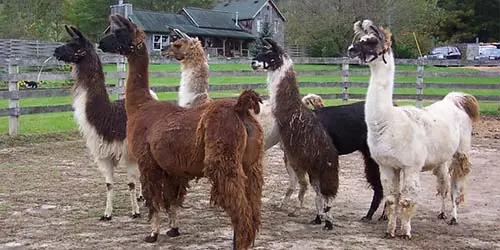Llamas are very social animals that communicate with a complex set of signals. This form of communication, just like with human language, serves multiple vital functions.
Llamas communicate through visual, auditory, and chemical signals. All of these subtle signals need to transmit some social information and one signal can have more than one connotation.
In this article, we will look into one form of llama communication, the humming. We will answer and explain the question “why do llamas hum” and show you what a llama’s humming sounds like.

Table of Contents
Why Do Llamas Hum?
To communicate with other animals, llamas use a repertoire of sounds known as humming (bleating). They use humming sounds to express different moods or feelings to other llamas, animals, and humans in a variety of circumstances. When they are about to give birth, llamas will also hum.
Usually, humming is low in tone and very hard to hear. Depending on the tone and volume, every hum will have a different meaning.
Alpacas are generally more vocal than llamas.
Low-Pitched Humming
Llama mothers share a strong bond with their infants, the crias. During contact between the mother and her newborn, she will make a low volume, low pitched humming noise at the newborn llama, and the newborn will respond with a version of this same call.
Besides humming, the mother-cria bond is established through nose-to-nose touching and nuzzling of the cria.
The llama mother will stay with her young after parturition and will also spit or lunge to ward off strangers and other animals. It will defend its baby vigorously.
Also, one of the signals that a llama is ready to give birth is excessive vocalization (humming).
Soft hums will also occur between herd members of the llama tribe when communicating.
Deeper Humming
Adult llamas will use a deeper humming tone to communicate tension, discomfort, or pain between themselves. Llama babies that want to suckle will make higher-pitched tones with an inflection at the end.
When members of the herd get separated or reunited, they will hum loudly to express their concern or their pleasure. This is especially noticeable when infants get separated from their mothers.
When a young llama is frightened and gets separated from its mother, its humming will turn into a whistle-like distress hum.
Did you know that gorillas hum when happy, as well? Make sure to check the link.
Highly Aggressive Humming
During aggressive social interactions, usually between males, humming turns into snorting, clicking, and grumbling. This is followed by different ear and tail position displays.
A llama will scream when feeling extremely frightened. This happens in situations when the animal is restrained, captured, or getting sheared.
An agitated llama will snort which is characterized by a short burst of air through the mouth with loose lips. It might also make clicking sounds with its tongue.
During feeding, if a llama is approached too closely by another, it will make a grumbling threat sound. They will also make those sounds when they are ready to spit and regurgitate at another animal or a person.
To warn other llamas about the incoming danger, llamas will emit a particular alarm call consisting of high-pitched, rhythmic sounds. When they notice strange dogs or other predators approaching, llamas will emit a sharp staccato series of sounds. This makes them popular animals among livestock owners, as they can swiftly react to the alarm.
Veterinarians describe it as whistling or neighing; some say it is similar to the braying of a donkey.
When they hear this alarm call, llamas will become alerted and instantly turn toward the source of the sound.

When a male llama is mating or chasing a female, it will make rhythmic, expiratory, guttural grunting sounds. This humming sound is known as orgling.
Not as bad as what llama’s cousins, the camels, do. They will make gurgling sounds and spit out a weird pink balloon out of their mouths. This organ stinks, but female camels are crazy for it. Read more about it here.
When a male llama is chasing or fighting with another llama, usually during a territorial dispute, it will make a loud squealing sound called screeching.
When a llama is not humming, it should be taken as a cause of concern for its keeper.
What Does Llama Humming Sound Like?
Llama’s humming sounds similar to a human humming. Some say it also resembles a cat purring. High-pitched humming can sound like a donkey bray.
Here’s what the humming of adult llamas sounds like.
Here’s the sound of a mother llama humming to its infant.
And here’s how a llama hums when it gets separated from its mother.
Want to learn more about llamas? Here’s an article on how many stomachs a llama has.
Final Thoughts
This concludes our article going over the question “why do llamas hum”.
Llamas are smart and social animals that use humming sounds to communicate with their kind. Humming is a low sound and it can show how a llama feels. Low hums indicate closeness and content; the higher the tone, the more agitated and aggressive the llama is.
References
[1] Tynes, Valarie V., ed. Behavior of exotic pets. John Wiley & Sons, 2010.
[2] Fowler, Murray. Medicine and surgery of camelids. John Wiley & Sons, 2011.
[3] Peralta, Jose M., and Aubrey H. Fine, eds. The Welfare of Animals in Animal-assisted Interventions: Foundations and Best Practice Methods. Springer, 2021.
[4] Adams, G. P. “Theriogenology in llamas and alpacas.” Large Animal Veterinary Rounds 7.10 (2007).